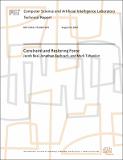Constraint and Restoring Force
Author(s)
Beal, Jacob; Bachrach, Jonathan; Tobenkin, Mark
DownloadMIT-CSAIL-TR-2007-044.pdf (887.8Kb)
Additional downloads
Other Contributors
Mathematics and Computation
Advisor
Gerald Sussman
Metadata
Show full item recordAbstract
Long-lived sensor network applications must be able to self-repair and adapt to changing demands. We introduce a new approach for doing so: Constraint and Restoring Force. CRF is a physics-inspired framework for computing scalar fields across a sensor network with occasional changes. We illustrate CRF’s usefulness by applying it to gradients, a common building block for sensor network systems. The resulting algorithm, CRF-Gradient, determines locally when to self-repair and when to stop and save energy. CRF-Gradient is self-stabilizing, converges in O(diameter) time, and has been verified experimentally in simulation and on a network of Mica2 motes. Finally we show how CRF can be applied to other algorithms as well, such as the calculation of probability fields.
Date issued
2007-08-24Other identifiers
MIT-CSAIL-TR-2007-044
Series/Report no.
Massachusetts Institute of Technology Computer Science and Artificial Intelligence Laboratory
Keywords
amorphous computing, spatial computing, Proto